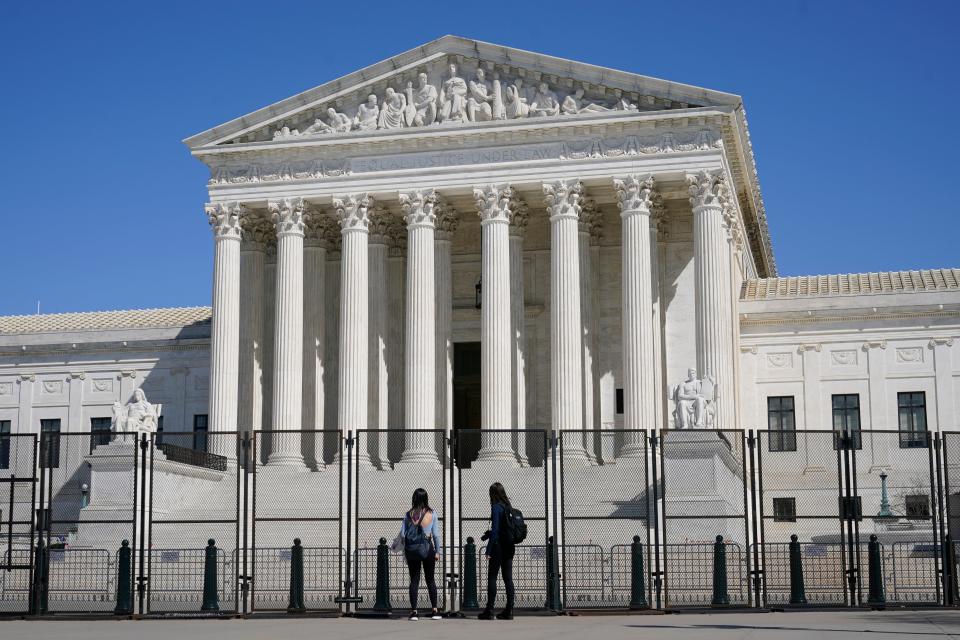'Nothing subtle about a bullet': Supreme Court says police 'seizure' includes shots fired at fleeing suspect
WASHINGTON – A divided Supreme Court on Thursday ruled that police can find themselves on the wrong side of the Fourth Amendment when they shoot at a fleeing suspect.
The 5-3 decision, written by Chief Justice John Roberts, stems from a 2014 incident in Albuquerque in which New Mexico State Police attempted to arrest a woman for white collar crimes. As the officers tried to enter Roxanne Torres' car, she sped off, later claiming that she thought the police were criminals attempting a car jacking.
As she drove away, the officers fired 13 shots, striking Torres twice in the back and temporarily paralyzing her left arm. She drove 75 miles to a hospital, but was ultimately airlifted to a hospital back in Albuquerque, where she was arrested the next day.
Roberts, joined by the court's liberal wing as well as Associate Justice Brett Kavanaugh, wrote that the physical force used by police represented a "seizure" under the Fourth Amendment even if the bullets failed to stop Torres. The opinion represents an expansion of Fourth Amendment protections at a time when the nation is wrestling with police use of force and split-second decisions made by law enforcement officers.
The Fourth Amendment protects people from unreasonable search and seizure by police and other government actors. The nation's highest court spends a considerable amount of time debating what words like "unreasonable" and, in this case, "seizure" mean when applied to on-the-ground policing.
"The officers’ shooting applied physical force to her body and objectively manifested an intent to restrain her from driving away," Roberts wrote. "We therefore conclude that the officers seized Torres for the instant that the bullets struck her."
More: Supreme Court wrestles with complex questions of tribal power
More: Federal courts look to expand security following Capitol riot, threats to judges
Associate Justice Neil Gorsuch dissented from the majority opinion and was joined by Associate Justices Clarence Thomas and Samuel Alito. Gorsuch asserted that the majority's view opens up a new area of Fourth Amendment protection that he suggested defies common sense.
"The majority holds that a criminal suspect can be simultaneously seized and roaming at large," Gorsuch wrote. "It’s a seizure even if the suspect refuses to stop, evades capture, and rides off into the sunset never to be seen again. That view is as mistaken as it is novel."
Instead, Gorsuch said, the word "seizure" should require the "taking possession of someone or something.

"There is a reason why, in two centuries filled with litigation over the Fourth Amendment’s meaning, this court has never before adopted the majority’s definition of a 'seizure,'" Gorsuch wrote. "Neither the Constitution nor common sense can sustain it."
Associate Justice Amy Coney Barrett, who was not yet seated on the court when the case was argued last fall, did not take part in the opinion.
Roberts stressed in the majority opinion that the court was not making a determination about whether the seizure in the case was reasonable under the Constitution, whether damages should be awarded or whether the police are protected under qualified immunity, which protects police and other government officials from certain lawsuits.
The court's opinion only dealt with what constitutes a seizure.
Those other questions, Roberts wrote, must be sorted out by lower courts.
"There is nothing subtle about a bullet," Roberts wrote, "but the Fourth Amendment preserves personal security with respect to methods of apprehension old and new."
This article originally appeared on USA TODAY: Supreme Court: Police 'seizure' includes shots fired at fleeing suspect

